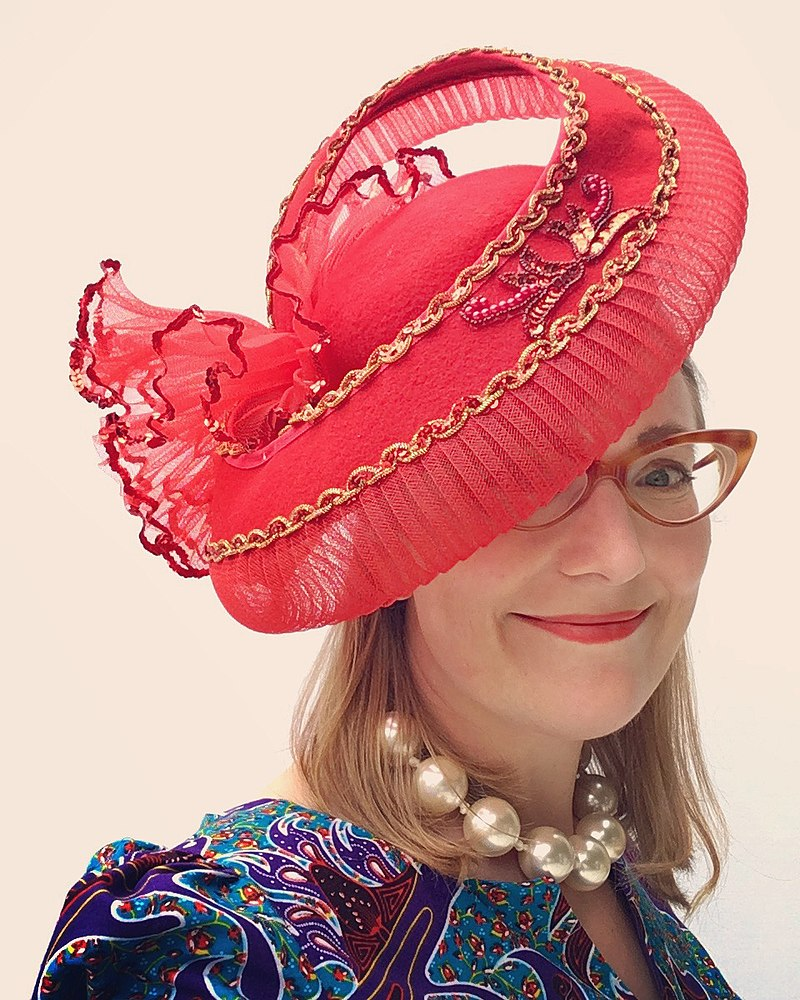Title of the work
Country of the First Edition
Country/countries of popularity
Original Language
First Edition Date
First Edition Details
Philip Reeve & Sarah McIntyre, Kevin’s Great Escape. Oxford: Oxford University Press, 2019, 157 pp.
ISBN
Genre
Action and adventure fiction
Fantasy fiction
Target Audience
Children (8–10 year olds)
Cover

We are still trying to obtain permission for posting the original cover.
Author of the Entry:
Elizabeth Hale, University of New England, ehale@une.edu.au
Peer-reviewer of the Entry:
Hanna Paulouskaya, University of Warsaw, hannapa@al.uw.edu.pl
Babette Puetz, Victoria University of Wellington, babette.puetz@vuw.ac.nz

Sarah McIntyre by Marmalade toast. Retrieved from Wikipedia, licensed under CC BY-SA 4.0 (accessed: January 26, 2022).
Sarah McIntyre (Illustrator)
Sarah McIntyre grew up in Seattle, Washington, and studied at Bryn Mawr College in Pennsylvania, graduating in 1999 with a degree in Russian literature. After graduating, she spent time in Russia, where she was inspired by the art, before moving to the United Kingdom to study for her Masters in Illustration at Camberwell College of Arts in 2007. She has written and illustrated several comics and picture books, including Grumpycorn, Don’t Call me Grumpycorn, There’s a Shark in the Bath, The New Neighbours. She collaborated with author Philip Reeve on several illustrated children’s books, including Oliver and the Seawigs, Thatch the Moon, Pugs of the Frozen North. She runs the Studio Teabreak twitter drawing challenges, and lives in the United Kingdom.
Sources:
Official website (accessed: September 16, 2020).
Profile at en.wikipedia.org (accessed: September 16, 2020).
Twitter (accessed: September 16, 2020).
Bio prepared by Elizabeth Hale, University of New England, ehale@une.edu.au

Retrieved from Wikipedia, public domain (accessed: December 30, 2021).
Philip Reeve
, b. 1966
(Author, Illustrator)
Philip Reeve was born on 28 February 1966 in Brighton. He studied illustration at Cambridgeshire College of Arts and Technology as well as at Brighton Polytechnic (now the University of Brighton). In his early professional life, he was occupied with writing comedy sketches and various no-budget theatre shows. He is an author and illustrator ofchildren's books. Due to lack of free time, he could no more work on film or theatre like he used to and turned to writing. As a result, he published his first novel entitled Mortal Engines (2001), currently being adapted for the screen by Peter Jackson. His other notable works are Here Lies Arthur, an alternative depiction of the Arthurian legend; the Larklight series in a steampunk setting; sequels to Mortal Engines, the Fever Crumb trilogy. In recent years Philip Reeve has been collaborating with Sarah McIntyre on illustrated books, the first of the series being Oliver and the Seawigs. Lives on Dartmoor with his family; loves writing, drawing, acting and history. Reeve has produced illustrations for many books including those in the Horrible Histories and Dead Famous series.
Sources:
Profile at the Wikipedia (accessed: June 25, 2018).
Profile at the www.mbalit.co.uk (accessed: February 10, 2017).
An interview about his books for children, is available on his publisher’s site (accessed: September 20, 2018)
Another interview, on the occasion of the release of Railhead (accessed September 20, 2018)
He answers questions about his writing preferences and process (accessed Semtember 20, 2018)
The Author’s Official Website
The Author’s Blog
Bio prepared by Agnieszka Maciejewska, University of Warsaw, agnieszka.maciejewska@student.uw.edu.pl and Joanna Bieńkowska, University of Warsaw, joanna.bienkowska@student.uw.edu.pl
Sequels, Prequels and Spin-offs
There are currently four novels in the ‘Roly Poly Flying Pony’ series:
The Legend of Kevin, Oxford: Oxford University Press, 2018.
Kevin’s Great Escape, Oxford: Oxford University Press, 2019.
Kevin and the Biscuit Bandit, Oxford: Oxford University Press, 2020.
Kevin vs the Unicorns, Oxford: Oxford University Press, 2021.
Summary
This is the second in the “Roly Poly Flying Pony” adventures, featuring Kevin, a chubby winged pony who nests in a tree in the wilds of Dartmoor, in Devon, England. Kevin becomes friends with a boy named Max, in The Legend of Kevin, and helps save the town of Bumbleford from flooding following a storm.
In this volume, famous pop star, Misty Twiglet, moves into Gloomsbury Grange, a mansion near Bumbleford. Her wicked agent, Baz Gumption, tricks Max’s sister, Daisy (who is a major fan of Misty Twiglet) into flying Kevin to the mansion and signing away the rights to the flying pony. Kevin is added to a menagerie of magical creatures (Iris: a mermaid, Cedric: a boy centaur, Zola: a girl gorgon, Belling: a little dragon, and a cardigan-wearing faun). Max and Daisy sneak into the Grange at night to rescue Kevin, but he tells them he can’t leave without his friends.
The following day, Max and Daisy return to Gloomsbury Grange, posing as a door-to-door unicorn seller. (They have dressed up Daisy’s guineapigs, Neville and Beyonce, as unicorns using seashells from Iris’s collection.) Zola uses her gorgon stare on Lumphammer, Max’s henchman, and the gang escapes. When Misty Twiglets returns from a trip to London, she is furious with Max Gumption, for stealing in her name. She fires Max and hires Iris the mermaid to do backing vocals for her new song. Cardigan Faun joins the band as guitar player, and Cedric plays the maracas. The new song is a huge success.
Analysis
Like its predecessor, The Legend of Kevin, Kevin’s Great Escape is a chapter book aimed at young readers who are transitioning from visual narratives to written works. It takes a humorous approach to mythology: Kevin, the roly-poly flying pony is a cuddly version of Pegasus, with a sweet tooth (he has a taste for custard cream biscuits) and a heart of gold. His new mythical friends: Cedric the Centaur, the Cardigan Faun, Zola the Gorgon, are gentle versions of centaurs, satyrs and gorgons, and have modified versions of their mythological powers. Zola, for instance, came last at school (Miss Medusa’s Academy) and has to work on her petrifying stare.
The story flirts with the gothic: Daisy, Max’s sister, in a reference to the tv personality Elvira Mistress of the Dark, has an alter-ego named Elvira, and Misty Twiglet is a gothic singer. The idea of the creepy mansion where mythical creatures are kept in captivity also connects with the gothic: the idea of the uncanny is, however, given a comic edge in this story, which ends happily with the community coming together to hear Misty and her newfound mythical creatures joining in song. (In this, there are parallels with the conclusion of The Enchanted Castle (1907), by Edith Nesbit, in which statues of the Olympian gods come to life on a mysterious grand estate, and which concludes with all the figures joining with the human protagonists in a communal rite.)
Reeve is a well-known writer of young adult fantasy, and this work seems firmly in the tradition of British children’s fantasy, in which supernatural creatures from many traditions come together in a way that re-enforces the fun of make-believe. The influence of British fantasists such as C. S. Lewis can be seen in the cornucopia of mythical traditions, which brings together dragons and sea monkeys, as well as figures form the Greek myths. Furthermore, the vision of mythical creatures as essentially friendly, despite their magical allure, can be seen in characters such as Cardigan Faun, who seems to be strongly influenced by Lewis’s Mr Tumnus, the faun who draws Lucy Pevensey into the world of Narnia.
Further Reading
Murnaghan, Sheila and Deborah H. Roberts, Childhood and the Classics: Britain and America, 1850–1965, Oxford: Oxford University Press, 2018.
Hale, Elizabeth, “Classics, Children’s Literature, and the Character of Childhood, from Tom Brown’s Schooldays to The Enchanted Castle” in Lisa Maurice, ed., The Reception of Ancient Greece and Rome in Children’s Literature, Leiden: Brill, 2015, 15–29.
C.S. Lewis, The Lion, the Witch and the Wardrobe, U.K.: Geoffrey Bles, 1950.
Nesbit, Edith, The Enchanted Castle, London: T. Fisher Unwin, 1907.


